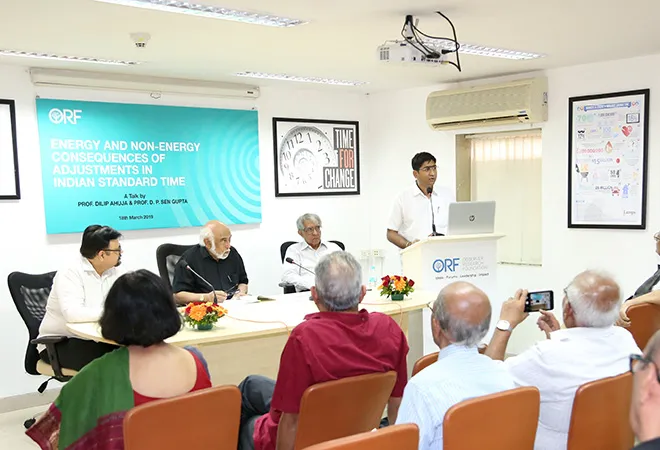-
CENTRES
Progammes & Centres
Location
A talk by Prof Dilip Ahuja and Prof D P Sen Gupta

Advancing the Indian Standard Time by 30 minutes will lead to savings of energy to the tune of 2.7 billion units (as per 2009 estimates which currently will be close to 3.5 billion units). Additionally, it could also benefit in mainstreaming the Northeastern region of India, increased security for women as they would not have to travel during dark hours, better national productivity, reduction in possibility of road accidents, and a range of other tangible and non-tangible benefits. Prof Dilip Ahuja and Prof D. P. Sen Gupta shared the results of their four-decade long research in their talk on ‘Energy and non-energy consequences in adjustments of Indian Standard Time’ at ORF Mumbai on 18 March 2019.
For a long time there have been debates around India having two time zones as a potential solution to addressing problems relating to early sunrise in summers and early sunset in winters. However, the study by Profs Ahuja and Sen Gupta has proposed that marginally advancing the IST by 30 minutes will be the most optimal solution for the country.
The professors began their talk by briefing the audience about the timeline of evolution and global agreement on a common international standard time. They also mentioned that different time zones had existed in British India and how the country arrived at a common Indian Standard Time (IST). The geographical vastness of India ning about 2,933 kilometers between its western and eastern points as noted by various experts have led to demands from different quarters for two separate time zones. But, Prof Ahuja and Prof Sen Gupta concluded that having two different time zones could lead to confusion, possibility of accidents and could be used as a political means to divide the country.
The study was initially commissioned by Bureau of Energy Efficiency, Ministry of Power upon the request of Department of Economic Affairs and later supported by Ministry of Earth Sciences, Government of India. During their talk, the researchers presented their methodology, approach and results which reinforces their claim of advancing the Indian Standard Time for India’s benefit. They emphasised that the proposed policy measure will not require people to make major adjustments in their lifestyle.
Usually when a country adjusts time to optimise its energy use, it has the option of either advancing the time throughout the year or have summer daylight savings time where clocks have to be adjusted for some part of the year or carve out multiple time zones. Prof Ahuja and Prof Sen Gupta have made an assessment of all the three existing options to analyse energy and non-energy benefits.
Through their research, they found that daylight saving hours would save the highest amount of energy, but given the accompanying difficulty of expecting an average citizen to make time adjustments twice in a year, they explored the other alternative of marginally advancing the IST by 30 minutes as the most suitable option. They also demonstrated how such an adjustment would integrate India with the global norm by removing its current non-integer time zone with the GMT.
One of the major parts of their study was to assess the energy saving that would be realised after advancing IST. An analysis of region-wise (Western, Northern, Eastern, Northeastern and Southern) electricity load curve data to calculate the savings in electricity consumption due to reduced lighting needs revealed that peak electricity demand occurred in the evening when people are back home from work. Meeting this peak load demand has traditionally been a challenge for electricity supply companies. By advancing IST, the peak load demand in the evening will be reduced by 17 to 18 percent. Changing the IST to GMT + 6:00 will save India about 3.5 billion units annually, year-after-year which is about 0.3 percent to 0.4 percent of annual consumption. While the percentage saving of energy units may seem negligible, this would result into voluminous savings in monetary terms and carbon emissions. As more households are electrified and there is less load shedding with improved electricity supply, advancing IST will only add to the energy saving in the long-term.
Prof Ahuja and Prof Sen Gupta have also compared their research with other similar studies which have been commissioned in countries around the world. The results are similar to most of them, which helps in corroborating their efforts. There will be minor dis-benefits as well when such a change is undertaken. Later winter sunrises will cause some inconvenience for parents of school going children and there could be potential postponements in flight timings on days of winter morning fog. Also, in order to bring this proposal in effect, stakeholders like transportation systems, manual time keepers, and even astrologers etc. will have to adapt on the day when the clock is advanced.
Both the professors mentioned that they have made representations to several stakeholders in the policy-making circles and conveyed the need to advance IST by 30 minutes. Their proposal has been endorsed by several ministries of the central government. Although, the scientists stated that their recommendation will get anywhere near implementation only if and when there is a strong political will that will drive such a change.
This event report has been jointly prepared by Ameya Pimpalkhare, Associate Fellow, ORF and Sanket Sudhir Kulkani, Fellow ORF, both based at ORF’s Mumbai chapter.
The views expressed above belong to the author(s). ORF research and analyses now available on Telegram! Click here to access our curated content — blogs, longforms and interviews.